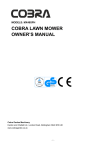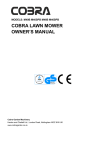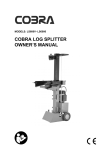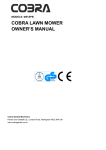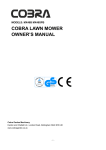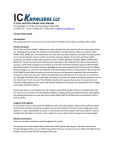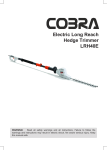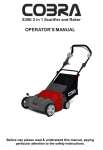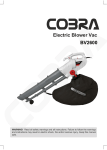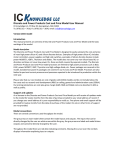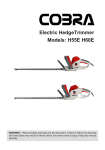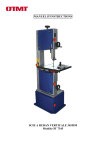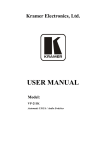Download User Manual
Transcript
MODELS: T40B T60RB COBRA CULTIVATOR / TILLER OWNER’S MANUAL Cobra Garden Machinery Henton and Chattell Ltd., London Road, Nottingham NG2 3HW UK www.cobragarden.co.uk 1 CONTENTS SECTION 1 SAFETY LABELS ……………..………….…………………………. 3 SECTION 2 SAFETY INSTRUCTION…………………………………………….. 4 SECTION 3 COMPONENTS ………………………………………………………. 6 SECTION 4 TECHNICAL DATA…………………………………………………..... 7 SECTION 5 ASSEMBLY ……………………………………………………………. 8 SECTION 6 CONTROLS……………………………………………………………. 15 SECTION 7 BEFORE OPERATION……………………………………………….. 17 SECTION 8 OPERATION…………………………………………………………… 18 SECTION 9 SERVICING……………………………………………………………. 19 SECTION 10 STORAGE……………………………………………………………. 23 SECTION 11 TRANSPORTING……………………………………………………. 23 SECTION 12 WARRANTY …...……………………………………………………. 24 SECTION 13 ENVIRONMENT ……………………………………………………. 24 SECTION 14 EC-DECLARATION OF CONFORMITY………………………….. 25 2 3 1. SAFETY LABELS The following safety labels appear on the machine. They are there to remind you of the care and attention required in use. This is what the symbols mean: Read Operator's Manual Danger! Rotating work machine. When repairing, please pick up the spark plug, and then repair it according to the operational manual. Keep Bystanders Away Fuel is flammable, keep fire away. Do not add fuel with running machine. Toxic fumes; don’t operate inside house. When working, please wear the glasses and ear plugs to defend the operator himself. Caution: Engine hot. 4 2. SAFETY INSTRUCTION WARNING: When using petrol tools, basic safety precautions, including the following, should always be followed to reduce the risk of serious personal injury and/or damage to the unit. Read all these instruction before operating this product and retain these instructions for future reference. WARNING: This machine produces an electromagnetic field during operation. This field may under some circumstances interfere with active or passive medical implants. To reduce the risk of serious or fatal injury, we recommend persons with medical implants to consult their physician and the medical implant manufacturer before operating this machine. Training 1. Before using the tiller read the instructions carefully. Familiarise yourself with the controls and pay particular attention in learning how to stop the machine in an emergency. 2. Never allow children or people unfamiliar with these instructions to use the tiller. Local regulations can restrict the age of the operator. 3. Never operate while people, especially children or pets are nearby. 4. Never use the tiller if the operator is taking medicine or substances that could affect or impair his ability to react or concentrate. 5. Keep in mind that the operator or user is responsible for accidents or hazards occurring to other people or their property. Before you start 1. While operating the tiller, always wear substantial footwear and long trousers. Do not operate the equipment when barefoot or wearing open toed sandals. 2. Thoroughly inspect the area where the equipment is to be used and remove all objects which can damage or be thrown by the machine. 3. WARNING - Petrol is highly flammable. - Store fuel in containers specifically designed for this purpose. Refuel outdoors only and do not smoke while refuelling; add fuel before starting the engine. Never remove the cap of the fuel tank or add petrol while the engine is running or when the engine is hot. If petrol is spilled, do not attempt to start the engine, but move the machine away from the area of - spillage and avoid creating any source of ignition until petrol vapours have dissipated. - Replace all fuel tank and container caps securely. 4. Replace faulty silencers. 5. Before using, always visually inspect to see that the blade, blade bolts and cutter assembly are not worn or damaged. Replace worn or damaged blades and bolts in sets to preserve balance. Operation and Caution 1. Do not operate the engine in a confined space where dangerous carbon monoxide fumes can collect, refuel outdoors only. 2. Operate only in daylight or in good artificial light. 3. 4. 5. 6. 7. 8. Avoid operating the equipment in wet grass, where feasible. Always be sure of your footing on slopes. Walk, never run, always be in control of the tiller and never allow yourself to be pulled along. Exercise extreme caution when changing direction on slopes. Do not operate on excessively steep slopes of more than 20° Use extreme caution when reversing or pulling the tiller towards you. 5 9. Never operate the tiller with defective guards, covers or without safety devices in place. 10. Do not change the engine governor settings or over speed the engine. 11. Before starting the engine disengage the cultivator blade and drive clutches. 12. Keep your feet well away from the blade when starting the engine and in accordance with the instructions. 13. Do not tilt the tiller when starting the engine and always start on a flat surface. 14. Never put hands or feet near or under rotating parts. 15. Always ensure the engine is fully switched off before picking up/carrying the tiller. 16. Stop the engine and disconnect the spark plug wire, make sure that all moving parts have come to a complete stop and, where a key is fitted remove the key, make sure engine has had time to cool. - Before clearing the cultivator tines / blades - Before checking, cleaning or working on the tiller. - After striking a foreign object. Inspect the tiller for damage and make repairs before restarting. - If the tiller starts to vibrate abnormally (check immediately). 17. Stop the engine and disconnect the spark plug wire, make sure that all moving parts have come to a complete stop and, where a key is fitted remove the key, make sure engine is completely cooled. - Whenever you leave the tiller. - Before refuelling. 18. Reduce the throttle setting during engine shut down and, if the engine is provided with a shut-off valve, turn the fuel valve off. Maintenance and Storage 1. Keep all nuts, bolts and screws tight to be sure the equipment is in safe working condition. 2. Never store the equipment with petrol in the tank inside a building where fuel vapours can reach an open flame or spark or where the temperature is high. 3. Before storage allow the engine to cool. 4. To reduce the fire hazard, keep the engine, silencer, battery compartment and petrol storage area free of grass, leaves, or excessive grease. 6. Replace worn or damaged parts for safety. Genuine parts should always be used as parts of inferior quality can damage the equipment and compromise safety. 7. If the fuel tank has to be drained, this should be done outdoors. Always ensure engine is completely cooled before starting this task. 8. If the cultivator blades/tines needs to be removed, wear strong gloves to prevent injury to hands and fingers. 9. When transporting the machine make sure you close the fuel cut off. Be careful to ensure weight is evenly distributed. Wear strong gloves. 10. When tilting the machine never tilt towards the air filter as this may become damaged with fuel. 11. Never crank the engine when the spark plug is removed. 12. Frequently check the fuel lines and fittings for damage and cracks, replace if necessary 13. Never start the engine with the air filter cover removed. 14. Carefully clean the tiller after use to remove debris as this can damage and corrode. Warning: Do not touch rotating tines/blade. Warning: Refuel in a well ventilated area with the engine stopped 6 3. COMPONENTS Fig. 1A T60RB – alternative engine for illustration purposes only 1. Front wheel 2.Spark plug 3.Starter handle 4. Fuel cap 7. Reverse handle 10. Cable clamp 13. Depth regulator 5.Handle 8. Locking button 11. Locking knob 14. Protective Plate 6.Clutch handle 9.Choke throttle lever 12.Fender 15. Blade Fig. 1F T40B Fig. 1G T60RB 7 4. TECHNICAL DATA Type T40B Motor Briggs 500E 3 Engine displacement 140 cm Rated engine power 2.18 kW Blade width 400mm Blade diameter 280mm Fuel capacity Max.engine speed Net weight 0.8L 3600/min 30.5kg Sound pressure level at operator’s 76.8dB(A), position (According to EN 709) K=3 dB(A) Measured Sound power level LWA 91.66dB(A), (According to EN 709) K=2.5 dB(A) Guaranteed Sound Power level 93 dB(A) (According to 2000/14/EC) Vibration(According to EN 709) 2 3.060m/s , K=1.5m/s 2 Type T60RB Motor Briggs 800E 3 Engine displacement 190 cm Rated engine power 3.68kW Blade width 600mm Blade diameter 280mm Fuel capacity Max.engine speed Net weight 1.1L 3600/min 47kg Sound pressure level at operator’s 78.6dB(A), position (According to EN 709) K=3 dB(A) Measured Sound power level LWA, 91.59dB(A) (According to EN 709) Guaranteed Sound Power level ,K=2.5 dB(A) 94dB(A) (According to 2000/14/EC) Vibration(According to EN 709) 2 5.214m/s , K=1.5m/s 2 8 5. ASSEMBLY For T40B 5.1 Assembly the blade 5.1.1 Insert the left blade and right blade into the both side of the transmission shaft. (Fig. 2A/ B/2C/2D/2E/2F) 5.1.2 Fix the blade and transmission shaft with the bolt and fixed pin. (Fig. 2G/2H/2I) Left blade Fig.2A Fig.2B Fig.2C Right blade Fig.2D Fig.2E Fig.2F Fixed pin Bolt Fig.2G Fig.2H Fig.2I 5.2 Assemble the depth regulator 5.2.1 Loosen the locking knob and then move the depth regulator from the machine. (Fig.3A) 5.2.2 Insert the depth regulator into the hole of the machine from bottom to top as show. (Fig. 3B/3C) 5.2.3 Tighten the locking knob. (Fig. 3D) Locking knob Fig.3A Fig.3B Fig.3C 9 Fig.3D 5.3 Assemble the front wheel 5.3.1 Insert the drivepipe into the hole of front wheel. (Fig. 3A/3B) 5.3.2 Fixed the front wheel and wheel support with bolt and nut. (Fig. 3C/3D/3E) Drivepipe Fig. 3A Fig. 3B Fig. 3C Bolt M10X75 Nut Fig. 3D Fig. 3E 5.4 Assemble the handle support 5.4.1 Fix the handle support into the unit body with bolt and nut supplied as Fig. 5A/5B/5C/5D shown. 5.4.2 Tighten the nut. Bolt M8X.60 Fig.5A Fig.5B Fig.5C Fig.5D 5.5 Assembly the handle 5.5.1 Connect the handle and handle support with the 1 bolt, and 1 nut supplied as Fig. 6A/6B /6C /6D show. 10 5.5.2 Tighten the nuts. (Fig. 6E) Fig.6A Fig.6B Fig.6C Bolt M8X60 Fig.6D Fig.6E 5.5.3 Adjustment to the handle height 5.5.3.1 Move the handle up and down adjusted it to the proper height. There are 2 adjusting height to be choose on this tiller; at 1 position, handle to the ground is highest, 2 position is the lowest. 5.5.3.2 Connect the handle and handle support with the 1 bolt, and 1 locking knob supplied as 1 Bolt M8X65 2 Fig.7A Fig.7B Fig.7C 5.5.4 Attach the cable-clamp to the position shown and then attach the cable. Cable clamp Fig.8A Fig.8B Fig.8C 11 Fig.8D T40B with Alternative engine – for illustration purposes 5. ASSEMBLY - For T60RB 5.6 Assemble the blade 5.6.1 Connect the right blade assembly as shown Fig. 9A/9B/9C/9D 5.6.2 Fix the blade assembly with the bolt and fixed pin. (Fig. 9E/9F/9G) 5.6.3 Assemble the left blade in the same way. Fig. 9A Fig. 9B Fig. 9D Fig. 9C Fig. 9E Bolt Fixed pin Fig. 9F Fig. 9G 12 5.7 Assemble the Protective Plate 5.7.1 Insert the protective plate into the blade assembly and fixed with bolt and fixed pin. (Fig. 10A/10B/10C/10D) 5.7.2 Assemble the right blade in the same way. 5.7.3 Insert the blade assembly into the transmission shaft both side with the bolt and fixed pin. (Fig. 10E/10F/10G/10H/10I) Fig. 10A Fig. 10B Bolt Fig. 10C Fig. 10D Fig. 10E Fig. 10F Bolt Fixed pin Fig. 10G Fig. 10H Fig. 10I 13 5.8 Assemble the depth regulator 5.8.1 Loosen the locking knob and then remove the depth regulator from the machine. (Fig. 11A) 5.8.2 Insert the depth regulator into the hole of the machine from bottom to top as show. (Fig. 11B) 5.8.3 Tighten the locking knob. (Fig. 11C) Locking knob Fig. 11A Fig. 11B Fig. 11C 5.9 Assemble the front wheel 5.9.1 Insert the drive-pipe into the hole of front wheel. (Fig. 12A/12B) 5.9.2 Fix the front wheel and wheel support with bolt and nut. (Fig. 12C/12D/12E) Drivepipe Fig. 12A Fig. 12B Fig. 12C Bolt M10X75 Nut Fig. 12D Fig. 12E 5.10 Assemble the Fender 5.10.1 Fix the fender into the unit body with screws. (Fig. 13A/13B) 5.10.2 Fix the other fender in the same way. 14 Screw M6X14 Fig. 13A 5.11 Assemble the handle Fig. 13B 5.11.1 Fix the handle panel with screws and washers. (Fig. 14A/14B) 5.11.2 Fix the handle into the unit body with screws, nut and bolt. (Fig. 14C/14D/14E/14F) Fig. 14A Fig. 14B Fig. 14C Bolt M8X95 Nut Fig.14D Fig.14E Fig.14F 5.12 Adjustment to the handle height 5.12.1 Move the handle up or down, adjustment it to the proper height. There are 3 adjustment heights; at the 3rd position the handle to the ground is the highest, at 1st position it is the lowest. 5.12.2 Fix the handle with the bolt and locking knob. (Fig. 15A/15B/15C) 5.12.3 Attach the cable-clamp to the position shown and then attach the cable. (Fig. 15D/15E) 15 1 Bolt M8*25 Locking knob 2 3 Fig. 15A Cable clamp Fig. 15D Fig. 15B Fig. 15C Cable clamp Fig. 15E 6. CONTROLS 6.1 CHOKE THROTTLE LEVER The throttle lever controls engine speed. For T40B and T60RB (Fig. 17A) When starting the engine from cold turn throttle choke lever to “ ”position. When starting a warm engine and operating, turn throttle choke lever to “ Fig. 17A Fig. 17B 16 ”position. 6.3 RECOIL STARTER GRIP Pulling the starter grip operates the recoil starter to crank the engine. Fig. 18 6.4 CLUTCH HANDLE AND REVERSE HANDLE The right handle: Connects the worm bar and engine output shaft to drive the tiller blade, when the clutch handle is press down. 6.4.1 T60RB Press the lock button (1) and meanwhile press down the clutch handle (2) and keep it in grasp, the machine will move forward. (Fig. 19A/19B) Release the clutch handle to stop the machine to moving on. 6.4.2 Press the lock button (1) and Press down the reverse handle (2) and keep it grasped, the machine will reverse automatically. (Fig. 19C/19B) Release the reverse handle, the tiller will stop operating in reverse. Catch handle Locking knob Locking knob Reverse handle Fig. 19A Fig. 19B Fig. 19C 6.4.3 for T40B Press the lock button (1) and meanwhile press down the clutch handle (2) and keep it grasped, the machine will move forward. (Fig.29D) Release the clutch handle to stop the machine from moving forward. Locking knob Catch handle Fig. 19D 17 6.5 ADJUSTMENT OF THE DEPTH REGULATOR a) Loosen the locking knob. (Fig. 20A) b) Align the hole on the regulator and adjustment the depth (4 position). The deepest position is position 1, the shallowest position is position 4. (Fig. 20B) c) Tighten the locking knob. Locking knob Fig. 20A Fig. 20B 7. BEFORE OPERATION 7.1 CHECK THE GENERAL CONDITION ● Look around and underneath the engine for signs of oil or petrol leaks. ● Remove any excessive dirt or debris, especially around the exhaust and recoil starter. ● Look for signs of damage. ● Check that all shields and covers are in place, and all nuts, bolts, and screws are tightened. 7.2 CHECK THE ENGINE ● Check the oil level. (see 9.5) For convenience to transporting, there is no fuel and oil in the engine, Fill the engine with oil before using. ● Check the air filter. (see 9.9) ● Check the fuel level. (see 9.4) NOTICE: The engine can be seriously damaged without oil. Always check the oil level before using. The machine must stand on level ground when checking. 8. OPERATION Caution! If the tiller is equipped with fenders. The engine should never be started without it or with a defect fender. 8.1 STARTING THE ENGINE For T40B and T60RB 8.1.8 The unit is equipped with a rubber boot over the end of the spark plug, make certain the metal loop on the end of the spark plug wire (inside the rubber boot) is fastened securely over the metal tip on the spark plug. 8.1.9 Press the primer bulb 3-5 times before starting the engine. (Only for T40B) (Fig. 23A) 8.1.10 When starting, turn the throttle choke lever to “ ” position. (Fig .23B) 8.1.11 Standing behind the unit, pull the starter grip lightly until you feel resistance then pull briskly. Return the starter grip gently. When the engine starts, set the throttle lever on a suitable position. (Fig. 23C) 18 Primer bulb Fig. 23A Fig. 23B Fig. 23C 8.2 STOPPING THE ENGINE To stop the engine in an emergency, simply press the handle switch to the “ ” position. Under normal conditions, use the following procedure: 1. Move the choke throttle lever to the “ ”position. 8.3 OPERATING THE TILLER 8.3.1 Pull the front wheel support of the tiller with one hand for downward and moved to the slot. (Fig. 24B/24C) 8.3.2 Start the engine as above. Let the engine run a few minutes to warm up before use. 8.3.3 Press the lock button (1) and meanwhile press down the clutch handle (2) and keep it held, the machine will move forward. (Fig. 24A) Release the clutch handle to stop the machine to move on. 8.3.4 Press the lock button (1) and press down the reverse handle (2) and keep it held, the machine will reverse automatically. (Fig. 24D) T60RB Release the reverse handle, the tiller will stop reversing. Clutch handle Slot Fig. 24A Fig. 24B Fig. 24C Reverse handle Abb. 24D 19 WARNING: Before clearing the tine blades, always: ● Release the clutch handle. ● Stop the engine. ● Disconnecting the spark plug cable. ● Wait up to 30 minutes after use, to allow the engine to cool. ● Do not put your hand inside the tiller blades. 8.4 AFTER USE 8.4.1 Check for loose or damaged parts. If required, change damaged parts. 8.4.2 Tighten loose screws and nuts. 8.4.3 Clean both tiller blades / tines. 8.4.4 Disconnect the spark plug cable. 9. SERVICING 9.1 SAFETY PRECAUTIONS Make sure the engine is off before you begin any maintenance or repair. This will eliminate several potential hazards: ● Carbon monoxide poisoning from engine exhaust. Never run the machine indoors. The exhaust fumes contain carbon monoxide. ● Burns from hot parts. Let the engine cool and up to 30 minutes after use before touching. ● Injury from moving parts. Read the instructions before you begin, and make sure you have the tools and skills required. To reduce the possibility of fire or explosion, be careful when working around petrol. Use only a nonflammable solvent, not petrol, to clean parts. Keep cigarettes, sparks and flames away from all fuel related parts. 20 9.2 MAINTENANCE SCHEDULE For Briggs and Stratton Engines First 5 Hours Change oil Every 8 Hours or Daily Check engine oil level Clean area around muffler and controls Clean finger guard Every 25 Hours or Annually Clean air filter Clean pre-cleaner Every 50 Hours or Annually Change engine oil Check muffler and spark plug Every 100 Hours Change gear reduction oil Annually Replace air filter Replace pre-cleaner Replace spark plug Replace fuel filter Clean air cooling system Check valve clearance (1) Service more frequently when used in dusty areas. (2) Change oil every 25 hours when used in heavy load or in high ambient temperatures. (3) These items should be serviced by a technician. (4) This product is not intend for commercial use, but longer hours of operation will increase maintenance intervals requirements. 9.3 REFUELING Use unleaded petrol only, check engine manual for further details. WARNING: Petrol is highly flammable and explosive, and you can be burned or seriously injured when refueling. ● Stop engine and keep heat, sparks, and flames away. ● Refuel only outdoors. ● Petrol is poisonous, be careful not to touch or inhale the vapours. 9.4 ADDING FUEL 9.4.1 Do not add fuel whilst the engine is running. 9.4.2 Add fuel to the bottom of the fuel level limit in the neck of the fuel tank. Do not overfill. Wipe up spilled fuel before starting the water pump. 9.5 ENGINE OIL LEVEL CHECK 9.5.1 Check the oil with engine stopped and level. 9.5.2 Remove the oil filler cap/dipstick and wipe it clean. 9.5.3 Insert the oil filler cap/dipstick into the oil filler neck as shown, but do not screw it in, then remove it to check the oil level. (Fig. 25A) 9.5.4 If the oil level is near or below the lower limit mark on the dipstick, remove the oil filler cap/dipstick, and 21 fill with the recommended oil to the upper limit mark. Do not overfill. (Fig. 25B) 9.5.5 Reinstall the oil filler cap/dipstick. Oil filler cap/ dipstick Fig. 25A MAX Fig. 25B 9.6 ENGINE OIL RECOMMENDATIONS For Briggs & Stratton Engines Oil is a major factor affecting performance and service life. Use 4-stroke automotive detergent oil SAE 10W-30 is recommended for general use. Outdoor temperatures determine the proper oil viscosity for the engine. Use the chart to select the best viscosity for the outdoor temperature range expected. * Below 40°F (4℃) the use of SAE 30 will result in hard starting. ** Above 80°F (27℃) the use of 10W-30 may cause increased oil consumption. Check oil level more frequently. 9.7 OIL CHANGE Drain the engine oil when the engine is warm. Warm oil drains quickly and completely. 9.7.1 Place a suitable container below the engine to catch the used oil. 9.7.2 Remove the Oil filler cap/ dipstick the oil into the container by slightly tipping the engine toward the oil filler cap/dipstick. 9.7.3 With the engine in a level position, fill to the upper limit mark on the dipstick with the recommended oil. 9.7.4 Reinstall the oil filler cap/dipstick securely. WARNING: Running the engine with a low oil level can cause engine damage. Engine oil is poisonous, be careful not to touch it. With the engine off but still warm, disconnect the spark plug wire and keep it away from the spark plug. We suggest you take used oil in a sealed container to your local recycling center or service station for reclamation. Do not throw it in the trash, pour it on the ground, or down a drain. 22 9.8 LUBRICATION WARNING: No service must be carried out before: The engine has stopped. The cable has been disconnected from the spark plug. Lubricate the linkage every 10 hours of use and before long time storage. Use 10W oil. No parts inside the gearbox are to be lubricated. All bearings and bushings are permanently lubricated and require no maintenance. Lubricating these parts will only result in the grease getting on to the friction wheel and disc drive plate, which could damage the rubber clad friction wheel. For longer term storage the above-mentioned parts should be lightly wiped with an oily rag to prevent rust. 9.9 AIR FILTER CLEANER SERVICE A dirty air filter will restrict air flow to the carburetor, reducing engine performance. If you operate the engine in very dusty areas, clean the air filter more often than specified in the MAINTENANCE SCHEDULE. NOTICE Operating the engine without an air filter, or with a damaged air filter, will allow dirt to enter the engine, causing rapid engine wear. 9.9.1 INSPECTION For the T40B To CLEAN THE AIR FILTER 1. Lift the tabs on top of the filter cover. (Fig. 26A) 2. Remove the cover. 3. Wash filter element in soap water. DO NOT USE PETROL! (Fig. 26B) 4. Air dry filter element. 5. Place a few drops of SAE30 oil on the filter element and squeeze tightly to remove any excess oil. 6. Reinstall the filter. NOTE: Replace filter if frayed, torn, damaged or unable to be cleaned. Fig. 26A Fig. 26B For the T60RB 1. Remove the locking knob. (Fig. 30A) 2. Remove the filter cover. (Fig. 30B) 3. Wash filter element in soap water. (Fig. 30C) DO NOT USE PETROL! 4. Air dry the filter element. 5. Place a few drops of SAE30 oil on the foam filter and squeeze tightly to remove any excess oil. 6. Reinstall filter. NOTE: Replace filter if frayed, torn, damaged or unable to be cleaned. 23 Fig. 30A Fig. 30B Fig. 30C 10. STORAGE Never store the machine with petrol in the fuel tank in a confined area with poor ventilation. Petrol fumes could reach open flames, sparks and cigarettes etc. If the machine is to be stored for a longer period than 30 days, the following method are recommended. 1. Empty the fuel tank. 2. Start the engine and let it run until it stops due to lack of fuel. 3. Change the engine oil if it has not been done for 3 months. 4. Remove the spark plug and empty a little engine oil (about 30 ml) in the hole. Crank the engine a couple of times. Screw back the spark plug. 5. Clean the whole machine thoroughly. 6. Lubricate all the parts as shown in LUBRICATING above. 7. Inspect the machine for damage, repair if necessary. 8. Touch up any paint damage. 9. Rust protection to the metal surfaces. 10. Store the machine indoors if possible. 11. TRANSPORTING If the engine has been running, allow it to cool for at least 15 minutes before loading the machine on the transport vehicle. A hot engine and exhaust system can burn you and can ignite some materials. Keep the engine upright when transporting to reduce the possibility of fuel leakage. 24 12. WARRANTY This product is warranted in accordance with legal regulations for a 24 month period effective from the date of purchase by the first user. This product will not be covered if used in a commercial application. This warranty covers all material or production failures, it does not include: defects from normal wear and tear, parts such as, bearings, brushes, cables, air cleaning elements, brake pad, clutch disc, tyre, wheel, recoil starter rope, belts, cutter blades, plugs, lubricant oils and grease or accessories. Damage or defects resulting from abuse, accidents or alterations, natural fading of painted or plated surfaces, sheet peeling and other natural deterioration. Any damage that occurs from the use of non-genuine Cobra parts will not be covered. We reserve the right to reject any claim where the purchase cannot be verified or when it is clear that the product was not maintained properly. (Clean ventilation slots, carbon brushes and serviced regularly) Expenses incidental to the warranty claim that are not covered; -Compensation for loss of time, commercial loss or rental costs of substitute product. -Costs incurred for transportation to and from the dealership. Any damage that occurs from the following will not be covered; exposure of the product to smoke and soot, chemical agents, bird droppings or other animal waste, seawater, sea breeze, salt or other environmental phenomena. Any damage resulting from operating methods other than those indicated in the owner’s manual will not be covered. Your purchase receipt must be kept as proof for date of purchase. Your un-dismantled mower must be returned to your dealer in an acceptably clean state, accompanied by your proof of purchase. Please Register Your Mower If your dealer did not collect registration information from you, please take a few minutes and register your purchase with Cobra. You can register by completing and mailing the registration card that should be in the box or by going online to: www.cobragarden.co.uk and clicking on Product Registration. Before using the lawn mower, all mower operators must read this manual 13. ENVIRONMENT Should your machine need replacement after extended use, do not put it in the domestic waste but dispose of it in an environmentally safe way. 25 14. EC-DECLARATION OF CONFORMITY EC Declaration of Conformity We herewith declare, Cobra Garden Machinery Henton & Chattell Ltd, London Road, Nottingham NG2 3HW United Kingdom that the following machine complies with the appropriate basic safety and health requirements of the EC Directive based on its design and type, as brought into circulation by us. In case of alteration of the machine, not agreed upon by us, this declaration will lose its validity Machine Description: Cultivator / Tiller Machine Type: T40B (7502) T60RB (7503) 3 190 cm 3 Displacement 140 cm Max, Cutting width 400mm Measured sound power level: 91.66dB(A) 91.59dB(A) Guaranteed sound power level: 93dB(A) 94dB(A) 600mm Notified Body for EC Directive 2000/14/EC:0499 TÜV Rheinland LGA Products GmbH Tillystrasse 2, 90431 Nürnberg,Germany 0197 Applicable EC Directives EC Machinery Directive:2006/42/EC EC Directive of Electromagnetic Compatibility:2004/108/EC EC Directive of noise emission: 2000/14/EC&2005/88/EC Applicable Harmonized Standards EN 709 EN ISO 14982 Authorized Signature/Date Peter J. Chaloner Title of Signatory 02-12-2013 Managing Director Name and address of the person authorized to compile the technical Cobra Garden Machinery file Henton & Chattell Ltd, London Road, Nottingham NG2 3HW United Kingdom 26



























